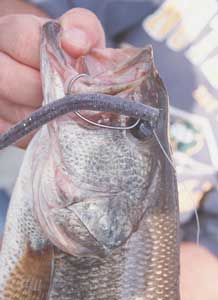
Robert Karbas of Wake Forest is the undisputed king of the Senko in North Carolina.He’s on a first-name basis with its inventor, Gary Yamamoto and buys them in bulk orders of 4,000 or 5,000 — he’s not on their pro staff, he just loves the bait — and he’s fished it so extensively he thinks he knows why no other companies’ knock-offs work anywhere close to as well as the Senko when it comes to drawing strikes from bass.
Or course, he’s not telling, but you get the picture.
Karbas, who fishes the FLW Tour across the country — he made the finals of last year’s FLW Tour Championship — said a Senko is a fairly simple bait to understand.
It’s a plastic worm that’s tapered on both ends, fat in the middle and heavier than the normal soft bait. Those features give it an unusual action as it floats down through the water column, and an even more unusual, quivering action when it’s on the bottom.
And Karbas has learned how to take advantage of that kind of action. He rigs it a handful of ways with different hooks to use in different situations.
“I fish it primarily three ways,” Karbas said. “When fishing it around a grass line, I use a hook made by Falcon Lures, a Gamakatsu G-Lock, which has a 1/32-ounce weight molded onto the shaft of the hook. I rig it Texas-style, and I fish it on 15-pound Seaguar fluorocarbon.
“When the bait falls, it falls at a 45-degree angle (because of the location of the weight), it still has that wobble when it falls, and when it hits bottom, it continues to quiver.
“I fish all my Senkos on fluorocarbon because of the feel, and because I’m making long casts with spinning tackle, I need a line that has no stretch so I can make a good hookset.”
The second way Karbas rigs a Senko is also a grass application but gives him a completely different action. He rigs the bait “wacky-style” with the point of the hook exposed through the middle of the thickest part of the bait. He fishes it with a 7-foot, medium-action spinning rod with 10-pound Seaguar and a 1/0 Owner “Skeeter” hook.
“I’m casting it up on the grass, and you’ll get hung up some in the woods, but the bite comes when you rip the bait out of the grass and it floats back,” he said. “You feel (the bass) get it, and you just tighten up and start reeling. The bite is that good.”
His third rigging technique is to use a Kahle-style hook made by Reaction Innovations. The hook is made with two heavy strands of monofilament that act as a weed guard. Karbas rigs it wacky style, but he’s got a particular task for the bait.
“I use that rig when I want to skip the bait up under a dock or willows or any kind of brush or logs,” he said.
He gets the wacky-style action, but the bait is also weedless.
There’s one other application that’s popular among some fishermen, and Karbas uses it occasionally.
Because the head of the worm is thicker and heavier than the tail, when he wants to flip or pitch the bait, he’ll Texas-rig it with a worm hook — only he hooks the bait through the tail end. That allows the heavier head end of the worm to actually sink away from the spot where it slides into the water.
That application can be changed slightly by using a Gambler Florida rig weight, the bullet weight with the screw-lock under the head. Screw a small sinker (1/8- or 3/16-ounce) into the head of the worm and Texas-rig it through the tail. The worm will sink away from the boat, and it will sink faster.
Karbas almost exclusively uses the larger 5-inch Senko in two colors — black-blue flake or green-pumpkin watermelon laminate.
When he’s fishing for spawning smallmouth bass, he’ll use a 4-inch Senko in a white-watermelon laminate color because bronzebacks tend to spawn deeper, and he wants a color he can more readily see.
“Really, a Senko is just a tremendous bait,” Karbas said. “I think there’s something about the bait that triggers a fish’s lateral line (where it senses movement in the water); it just devastates their lateral line. When they bite it, they never spit it out.
“Of all the great baits that have come out in the last 25 years — the Shad Rap or the Gitzit, for example — the Senko is the only bait where the knock-offs don’t work as well as the original bait.”




Be the first to comment